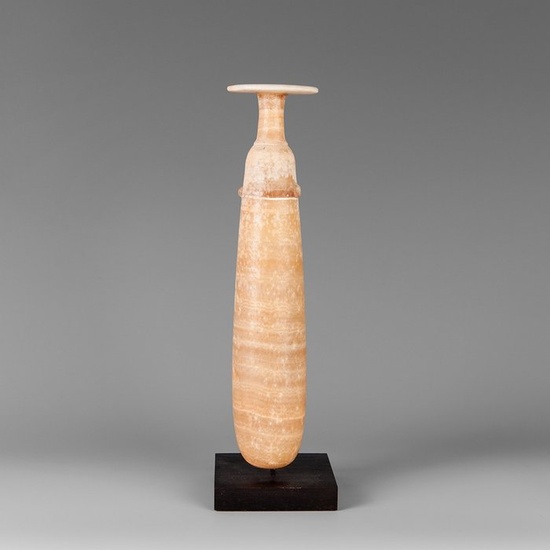Ancient Egyptian Alabaster Alabastron Vessel. Ptolemaic Period, 323 - 30 BC. H: 23.5 cm Spanish Export License.
Alabastron
Ancient Egypt, Ptolemaic Period, 323 - 30 BC.
Alabaster
Height 23. 5 cm
PROVENANCE: Private collection, England, acquired in 1980.
CONDITION: In a good state of preservation, the mouth is rejoined of three original fragments.
DESCRIPTION:
An Egyptian alabastron fashioned from alabaster. It is of a stylized ovoid form with a short, narrow neck and broad, flat mouth, designed to facilitate controlling the dose of the perfumed oil and its application to the skin.
This recipient in question is made up of two joined pieces, one, the ovoid body, and the other, the neck and the mouth.
Used in the ancient world for holding oil, especially perfume or massage oils. They originated around the 11th century BC in ancient Egypt as containers carved from alabaster – hence the name – but spread via ancient Greece to other parts of the classical world.
The design of the first Egyptian alabastra was inspired by the palm tree, with a columnar shape, a palm capital and a stand. Later designs were made from glass decorated with various patterns, such as scallops, festoons or abstract patterns of rings or zigzags.
Notes:
- The piece includes authenticity certificate.
- The piece includes Spanish Export License (Passport for European Union) - If the piece is destined outside the European Union a substitution of the export permit should be requested, can take between 1-2 weeks maximum.
- The seller guarantees that he acquired this piece according to all national and international laws related to the ownership of cultural property. Provenance statement seen by Catawiki.
View it on
Estimate
Time, Location
Auction House
Alabastron
Ancient Egypt, Ptolemaic Period, 323 - 30 BC.
Alabaster
Height 23. 5 cm
PROVENANCE: Private collection, England, acquired in 1980.
CONDITION: In a good state of preservation, the mouth is rejoined of three original fragments.
DESCRIPTION:
An Egyptian alabastron fashioned from alabaster. It is of a stylized ovoid form with a short, narrow neck and broad, flat mouth, designed to facilitate controlling the dose of the perfumed oil and its application to the skin.
This recipient in question is made up of two joined pieces, one, the ovoid body, and the other, the neck and the mouth.
Used in the ancient world for holding oil, especially perfume or massage oils. They originated around the 11th century BC in ancient Egypt as containers carved from alabaster – hence the name – but spread via ancient Greece to other parts of the classical world.
The design of the first Egyptian alabastra was inspired by the palm tree, with a columnar shape, a palm capital and a stand. Later designs were made from glass decorated with various patterns, such as scallops, festoons or abstract patterns of rings or zigzags.
Notes:
- The piece includes authenticity certificate.
- The piece includes Spanish Export License (Passport for European Union) - If the piece is destined outside the European Union a substitution of the export permit should be requested, can take between 1-2 weeks maximum.
- The seller guarantees that he acquired this piece according to all national and international laws related to the ownership of cultural property. Provenance statement seen by Catawiki.



